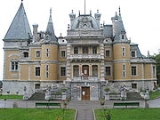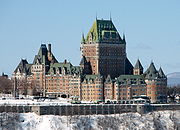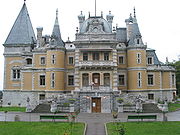
Châteauesque
Encyclopedia


Francis I of France
Francis I was King of France from 1515 until his death. During his reign, huge cultural changes took place in France and he has been called France's original Renaissance monarch...
style, and, in Canada
Canada
Canada is a North American country consisting of ten provinces and three territories. Located in the northern part of the continent, it extends from the Atlantic Ocean in the east to the Pacific Ocean in the west, and northward into the Arctic Ocean...
, the Château Style, that refer to a revival architectural style based on the French Renaissance architecture
French Renaissance architecture
French Renaissance architecture is the style of architecture which was imported to France from Italy during the early 16th century and developed in the light of local architectural traditions....
of the monumental French country homes (châteaux) built in the Loire Valley
Loire Valley
The Loire Valley , spanning , is located in the middle stretch of the Loire River in central France. Its area comprises approximately . It is referred to as the Cradle of the French Language, and the Garden of France due to the abundance of vineyards, fruit orchards, and artichoke, asparagus, and...
from the late fifteenth century to the early seventeenth century.
The term is credited (by historian Marcus Whiffen) to American architectural historian Bainbridge Bunting
Bainbridge Bunting
Bainbridge Bunting was an American architectural historian, teacher and author....
although it can be found in publications that pre-date Bunting's birth. As of 2011, the Getty Research Institute's Art & Architecture Thesaurus includes both "Château Style" and Châteauesque", with the former being the preferred term for North America.
The style frequently features buildings incongruously ornamented by the elaborate towers, spires, and steeply-pitched roofs of sixteenth century châteaux, (themselves influenced by late Gothic
Gothic architecture
Gothic architecture is a style of architecture that flourished during the high and late medieval period. It evolved from Romanesque architecture and was succeeded by Renaissance architecture....
and Italian Renaissance
Renaissance
The Renaissance was a cultural movement that spanned roughly the 14th to the 17th century, beginning in Italy in the Late Middle Ages and later spreading to the rest of Europe. The term is also used more loosely to refer to the historical era, but since the changes of the Renaissance were not...
architecture). Despite their French ornamentation, as a revival style
Revivalism (architecture)
Revivalism in architecture is the use of visual styles that consciously echo the style of a previous architectural era.There were a number of architectural revivalist movements in the United States in the 19th and early 20th centuries....
, buildings in the châteauesque style do not attempt to completely emulate a French château. Châteauesque buildings are typically built on an asymmetrical plan with an exceedingly broken roof-line and a facade composed of advancing and receding planes.
History
The style was popularized in the United States by Richard Morris HuntRichard Morris Hunt
Richard Morris Hunt was an American architect of the nineteenth century and a preeminent figure in the history of American architecture...
. Hunt, the first American architect to study at the École des Beaux-Arts
École des Beaux-Arts
École des Beaux-Arts refers to a number of influential art schools in France. The most famous is the École nationale supérieure des Beaux-Arts, now located on the left bank in Paris, across the Seine from the Louvre, in the 6th arrondissement. The school has a history spanning more than 350 years,...
in Paris, designed residences, including those for the Vanderbilt family
Vanderbilt
-People:*Vanderbilt *The Vanderbilt family**Cornelius Vanderbilt**William H. Vanderbilt-Places:In the United States:*Vanderbilt, California, a former gold-mining town*Vanderbilt, Michigan, a village*Vanderbilt, Pennsylvania, a borough...
during the 1870s, 1880s and 1890s. A relatively rare style in the United States, concentrated in the Northeast, it was mostly employed for residences of the extremely wealthy, though was occasionally used for public buildings.
The first building in this style in Canada was the 1887 Quebec City Armoury
Quebec City Armoury
The Quebec City Armoury or Grande-Allée Armoury was a Gothic Revival drill hall for the infantry regiment Les Voltigeurs de Québec in 805 Wilfrid-Laurier Avenue East, Quebec City, Canada. It was built between 1885 and 1888 and designed by architect Eugène-Étienne Taché...
. Many of Canada's grand railway hotels
Canada's grand railway hotels
Canada’s railway hotels are a series of grand hotels across the country, each a local and national landmark, and most of which are icons of Canadian history and architecture. Each hotel was originally built by the Canadian railway companies, or the railways acted as a catalyst for the hotel’s...
were built in the Châteauesque style, with other buildings mainly public or residential.
In Hungary, Arthur Meinig
Arthur Meinig
Arthur Meinig was a German-born Hungarian architect. He was born in Waldheim, Saxony in 1853 and died in Budapest on 14 September 1904. After studying in Dresden, he worked for architects Fellner and Helmer in Vienna. In 1883 he moved to Budapest and soon became the favorite architect of Hungarian...
built numerous country houses in the Loire Valley style. The earliest being Andrássy Castle in Tiszadob, 1885–1890 and the grandest being Károlyi Castle in Nagykároly (Carei), 1893–1895.
The style began to fade after the turn of the 20th century and was absent from new construction by the 1930s.
Architects who built Châteauesque structures
- Richard Morris HuntRichard Morris HuntRichard Morris Hunt was an American architect of the nineteenth century and a preeminent figure in the history of American architecture...
- Ross and MacdonaldRoss and MacdonaldRoss and Macdonald was one of Canada's most notable architecture firms in the early 20th century. Based in Montreal, Quebec, the firm originally operated as a partnership between George Allen Ross and David MacFarlane from 1907 to 1912. MacFarlane retired in 1913, and Robert Henry Macdonald...
- Sproatt and RolphHenry SproattHenry Sproatt was a Canadian architect in the early 20th Century.Born in Toronto, he trained in Europe and in New York. He formed a partnership with another celebrated architect, John A. Pearson in 1890 and with Frank Darling in 1893...
- Archibald and SchofieldArchibald and SchofieldArchibald and Schofield was a collaborative relationship between Canadian architects John Smith Archibald and John Schofield. They were known for their designs for the Canadian National Hotels for the Canadian National Railway....
- Francis RattenburyFrancis RattenburyFrancis Mawson Rattenbury was an architect born in England, although most of his career was spent in British Columbia, Canada where he designed many notable buildings. Divorced amid scandal, he was murdered in England at the age of 68 by his second wife's lover.- Architectural career :Rattenbury...
- Bruce PriceBruce PriceBruce Price was the American architect of many of the Canadian Pacific Railway's Château-type stations and hotels...
- Bradford GilbertBradford GilbertBradford Lee Gilbert was a nationally-active architect based in New York City.Gilbert is best known for designing the first steel-framed curtain wall building, the Tower Building, which opened at 50 Broadway in 1889. The Tower Building is considered New York City's first skyscraper...
, Ross and MacfarlaneRoss and MacdonaldRoss and Macdonald was one of Canada's most notable architecture firms in the early 20th century. Based in Montreal, Quebec, the firm originally operated as a partnership between George Allen Ross and David MacFarlane from 1907 to 1912. MacFarlane retired in 1913, and Robert Henry Macdonald... - Eugène-Étienne TachéEugène-Étienne TachéEugène-Étienne Taché was a French Canadian surveyor, civil engineer, illustrator and architect. He devised Quebec's provincial coat-of-arms and motto Je me souviens....
- Solon Spencer BemanSolon Spencer BemanSolon Spencer Beman was an American architect who was based in Chicago, best known as the architect of the planned Pullman community and adjacent Pullman Company factory complex. Several of his other largest commissions, including the Pullman Office Building, Pabst Building, and Grand Central...
See also
- Empire style
- French architecture
- Revivalism (architecture)Revivalism (architecture)Revivalism in architecture is the use of visual styles that consciously echo the style of a previous architectural era.There were a number of architectural revivalist movements in the United States in the 19th and early 20th centuries....

